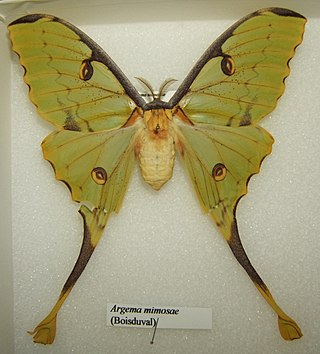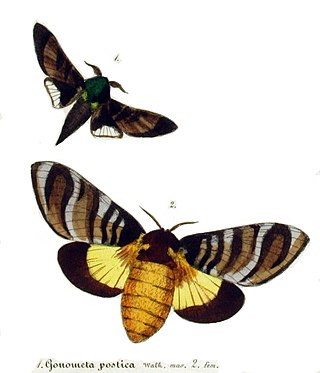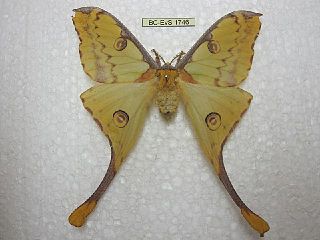
Lepidoptera or lepidopterans is an order of winged insects that includes butterflies and moths. About 180,000 species of the Lepidoptera have been described, representing 10% of the total described species of living organisms, making it the second largest insect order with 126 families and 46 superfamilies, and one of the most widespread and widely recognizable insect orders in the world.

Moths are a group of insects that includes all members of the order Lepidoptera that are not butterflies. They were previously classified as suborder Heterocera, but the group is paraphyletic with respect to butterflies and neither subordinate taxon is used in modern classifications. Moths make up the vast majority of the order. There are approximately 160,000 species of moth, many of which have yet to be described. Most species of moth are nocturnal, although there are also crepuscular and diurnal species.

The Sphingidae are a family of moths commonly called sphinx moths, also colloquially known as hawk moths, with many of their caterpillars known as "hornworms"; it includes about 1,450 species. It is best represented in the tropics, but species are found in every region. They are moderate to large in size and are distinguished among moths for their agile and sustained flying ability, similar enough to that of hummingbirds as to be reliably mistaken for them. Their narrow wings and streamlined abdomens are adaptations for rapid flight. The family was named by French zoologist Pierre André Latreille in 1802.

The geometer moths are moths belonging to the family Geometridae of the insect order Lepidoptera, the moths and butterflies. Their scientific name derives from the Ancient Greek geo γεω, and metron μέτρον "measure" in reference to the way their larvae, or inchworms, appear to measure the earth as they move along in a looping fashion. Geometridae is a very large family, containing around 23,000 described species; over 1400 species from six subfamilies are indigenous to North America alone. A well-known member is the peppered moth, Biston betularia, which has been the subject of numerous studies in population genetics. Several other geometer moths are notorious pests.

The Arctiinae are a large and diverse subfamily of moths with around 11,000 species found all over the world, including 6,000 neotropical species. This subfamily includes the groups commonly known as tiger moths, which usually have bright colours, footmen, which are usually much drabber, lichen moths, and wasp moths. Many species have "hairy" caterpillars that are popularly known as woolly bears or woolly worms. The scientific name Arctiinae refers to this hairiness. Some species within the Arctiinae have the word "tussock"' in their common names because they have been misidentified as members of the Lymantriinae subfamily based on the characteristics of the larvae.

The de Havilland DH.82 Tiger Moth is a 1930s British biplane designed by Geoffrey de Havilland and built by the de Havilland Aircraft Company. It was operated by the Royal Air Force (RAF) and other operators as a primary trainer aircraft. In addition to the type's principal use for ab initio training, the Second World War had RAF Tiger Moths operating in other capacities, including maritime surveillance and defensive anti-invasion preparations; some aircraft were even outfitted to function as armed light bombers.

The Tortricidae are a family of moths, commonly known as tortrix moths or leafroller moths, in the order Lepidoptera. This large family has over 11,000 species described, and is the sole member of the superfamily Tortricoidea, although the genus Heliocosma is sometimes placed within this superfamily. Many of these are economically important pests. Olethreutidae is a junior synonym. The typical resting posture is with the wings folded back, producing a rather rounded profile.
Moon moth is a general term describing imagos of several Saturniinae species, having as a distinctive trait large round or near-round spots on the forewings and hindwings - hence "moon".

The comet moth or Madagascan moon moth. is a moth native to the rain forests of Madagascar. The species was first described by Félix Édouard Guérin-Méneville in 1847. The adult moth cannot feed and only lives for 4 to 5 days. Although endangered in the wild due to habitat loss, the comet moth has been bred in captivity.

Actias is a genus of Saturniid moths, which contains the Asian-American moon moths. Long tails on their hindwings are among their distinctive traits. Other moths with similar appearance are Copiopteryx, Argema and Eudaemonia.

Actias ningpoana, the Chinese moon moth, is a species of moth in the family Saturniidae. The species was first described by father-and-son entomologists Cajetan and Rudolf Felder in 1862. It is quite large, and has long, curved, hindwing tails. There are many congeners across Asia; the Luna moth of eastern Canada and the United States is a close relative.

Argema mimosae, the African moon moth, is a giant silk moth of the family Saturniidae. Similar in appearance to the giant Madagascan moon moth, but smaller, this moth can be found widely in Eastern Africa and more locally in Southern Africa, including near the east coast of South Africa. The species was first described by Jean Baptiste Boisduval in 1847. An adult can measure 10 to 12 centimetres across its wingspan and 12 to 14 centimetres from head to the tip of its elongated tail-like second pair of wings. Its forward wings have a distinctive grey-coloured "furry" leading edge, giving a very rough surface, presumably for aerodynamic reasons. Apart from the eye-like markings on its wings, the colouring and shape of the wings give the appearance of a piece of foliage, especially the tail-like structures of the rearmost wings which resemble a dried out leaf stem - presumably for camouflage in its natural environment.

The Saturniinae or saturniines are a subfamily of the family Saturniidae, also known as giant silkmoths. They are commonly known as emperor moths or wild silk moths. They are easily spotted by the eyespots on the upper surface of their wings. Some exhibit realistic eye-like markings, whilst others have adapted the eyespots to form crescent moon or angular shapes or have lost their wing scales to create transparent windows. They are medium to very large moths, with adult wingspans ranging from 7.5 to 15 cm, in some cases even more. They consist of some of the largest sized Lepidoptera, such as the luna moth, atlas moth, and many more. The Saturniinae is an important source of wild silk and human food in many different cultures.

Dichelopa is a genus of moths belonging to the subfamily Tortricinae of the family Tortricidae.

The Erebidae are a family of moths in the superfamily Noctuoidea. The family is among the largest families of moths by species count and contains a wide variety of well-known macromoth groups. The family includes the underwings (Catocala); litter moths (Herminiinae); tiger, lichen, and wasp moths (Arctiinae); tussock moths (Lymantriinae), including the arctic woolly bear moth ; fruit-piercing moths ; micronoctuoid moths (Micronoctuini); snout moths (Hypeninae); and zales, though many of these common names can also refer to moths outside the Erebidae. Some of the erebid moths are called owlets.

Gonometa postica, known commonly as the African wild silk moth, burn worm, and brandwurm, is a large species of African moth belonging to the family Lasiocampidae. The genus Gonometa boasts some very large moths and larvae; Gonometa sjostedti from Africa has a larva 16 centimeters long, for example. Most of the Lasiocampidae are highly sexually dimorphic. In G. postica the forewing of the male measures 21–25 mm and of the female 35–42 mm.
Dichelopa argema is a species of moth of the family Tortricidae. It is found on the Marquesas Archipelago in French Polynesia.

Argema kuhnei is a moth in the family Saturniidae. It is found in the Democratic Republic of the Congo, Tanzania and Zambia.
Argema fournieri is a moth of the family Saturniidae. It is found in Cameroon and Nigeria.

Actias chapae or colloquially known as the 'celestial moon moth' is a moth in the family Saturniidae. It is found in Vietnam and China and potentially other countries in the region; it is a montane species recorded from 1500m and higher. It appears to be an exclusive pine feeder and has been raised on many different species of Pinus in captivity.

















